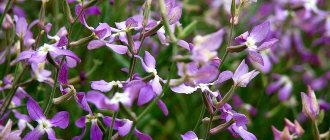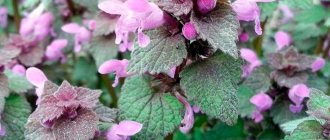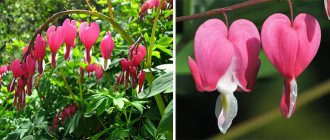A bright flower, intoxicating with its aroma, decorates many flower beds and garden plots in central Russia.
This plant is a “night resident”. With the onset of dusk, when nature freezes in anticipation of rain, its bright inflorescences on long stems, opening, fill the air with a subtle enchanting aroma.
We will tell you in detail about an unpretentious, easy-to-grow flower, ideal for creating group compositions for landscape design, the night violet flower: photos, planting and care and other aspects of cultivation.
Night violet
In our latitudes, the night viola (another name is “Esperis di Matrona”, “Matthiola”, “Evening of Matrona”) “moved” from warm Mediterranean Europe. The homeland of some varieties is located at the foot of the Caucasus, in Central Asia.
Vechernitsa is a perennial plant (lifespan exceeds 2 years). This is a herbaceous plant from the cruciferous family. Under natural conditions, it “loves” to settle both along roads and around rivers and lakes.
A cut bouquet retains its beauty and freshness in its original form throughout the week, perfectly complementing any flower arrangement.
Fragrant and bright inflorescences decorate the garden all summer - melting heads of cabbage in late spring and early autumn greet the sun.
The pointed, oblong-oval leaves delight the eye with a rich green color and a softer “fluff” to the touch.
For risky farming, gardeners mainly give preference to selected varieties of night violets with a lifespan of 1 year (the length of the above-ground part does not exceed 0.8 m, the vegetation is abundant and dense):
- Mattiola has two horns. Annual, up to 0.5 m high. Well-developed branching stems. The shape of the leaves is an elongated oval, with large teeth along the edges. Does not require pollination by insects. The flowering period is 40-50 days. The inflorescences are medium in size (no more than 3 cm), collected in a raceme. The color of the petals is pink, lilac-pink;
Mattiola has two horns.
- Gray-haired Mattiola (gray hair on the left). Features a rich color palette. The above-ground part consists of single or well-branched shoots (maximum height - 0.8 m, low-growing species - up to 0.15 m). Buds of regular shape with double petals (flowering period - 2 weeks, do not form seeds) or simple (flowering period - no more than 5 days), 4 pcs. In the bud.
Mattiola has gray hair.
Varieties also developed:
- "Evening perfume." Branched shoots up to 0.5 m tall, bright purple color of petals;
- "Star Light". It is distinguished by a strong aroma and a varied shade of the floral part. Grows up to 0.5 m;
- "Purple Night". Refers to medium-sized plants. Less attractive during the day, the buds are collected in loose clusters;
- "Lilac". A tall variety with well-branched stems, greens with jagged edges, a delicate aroma, flowers of small diameter with a soft purple hue.
ADVICE! Plants with low stems are an excellent decoration for apartment balconies and loggias, and are used to decorate garden paths.
general characteristics
Matrona's evening violet, also known as night violet or Matrona's hesperis (Hesperis matronalis) belongs to the Brassica family.
Despite the fact that in appearance these flowers do not look as regal as roses, dahlias or lilies, their extraordinary tenderness, simplicity and magical aroma make this flower somehow familiar, simple and natural. Not a single garden plot or flower bed in our area is complete without these lovely flowers. And in flower arrangements, this plant retains its fresh appearance for a long time and favorably emphasizes the beauty of the bouquet.
Usually Matrona's Evening is a perennial or biennial flower. Is popular and widely known. Sometimes called by this name - “bull phlox” because of the external similarity of these two garden plants. By the second half of August and until September, this decorative flower grows widely and stretches to about 1 meter.
In the 16th century, Matrona's Vechernitsa appeared in Europe, gained fame, and in the 18th century it forever became a favorite of Russian gardens, estates and parks. The homeland of the plant is considered to be the Eastern Mediterranean and Central Asia.
- Matrona has a slightly pubescent, strong stem that branches upward.
- The leaves have a rich, bright green color, narrow in diameter - only 3 cm, but long (more than 10 cm) and pointed at the top of the leaf. They are oval and lanceolate in shape and also have slight pubescence. They grow thickly.
- In the upper part of the stem, on high peduncles, there are inflorescences that are similar in color and structure to the branches of common lilac. The sepals are straight in shape and sac-shaped at the base.
- The petals are white, lilac, and shades of pink. The flower is about 2 cm in diameter and has 4 petals, which are arranged crosswise. The ovary of Hesperis is sessile, the column with petals is short in size. The stigma is bilobed in shape.
- The night violet also has fruits - pods of linear shape, slightly flattened, tetrahedral.
In total, there are more than 50 species of Matrona Vechernitsa, and in the central European part of Russia, mainly only 11 are found, here are some of them:
- Vespers are two-edged.
- Armenian.
- Persian Vespers.
- Evening violet.
- Steven's party.
- Gloomy.
- Lesnaya.
Terry varieties (purpurea plena), which have pinkish-red fluffy double inflorescences, have also been bred. But it should not be confused with Matthiola bicornuum. It is also mistakenly called night violet by some gardeners, but these are completely different plants.
The bush begins to bloom at the end of spring and lasts up to one and a half months. Although in hot, dry summers with little precipitation, hesperis fades faster.
Matrona's nocturnal plant reproduces using brown seeds that have excellent germination. They can be used for planting for about two years.
Seeds
Seed ripening begins at the end of the summer period (the last ten days of August) and continues until the beginning of autumn.
The seed material has a high germination rate; when sowing, it does not require deep digging (it is small).
When planting, it is necessary to maintain a distance to ensure a comfortable existence for future seedlings.
What do they look like?
Seeds in a box-pod (about 5 cm). They are almost black oblong dark brown in color, about 2-3 mm long. A sign of ripe seeds is a uniform bright color (clearly visible under a magnifying glass).
Where is the best place to buy them?
If you are a beginner gardener and have not previously grown night violet, then it is best to purchase plant seeds in specialized stores or from trusted breeders (it would be optimal to purchase a whole box of seeds indicating the subspecies of the parents and the variety).
you need to pay attention to:
- packaging integrity;
- shelf life of the product (until the end of the sale period must be at least 12 months);
- compliance with storage conditions: storage temperature - 12-15 degrees;
- choose planting material collected from well-known agricultural producers.
Can I get them myself?
If this plant already decorates your garden or balcony area, then you can prepare the seed material yourself:
- The seeds (found in pods - pods) are collected at the end of the growing season, after the first frost;
- The removed pod is left to dry for up to 2 weeks;
- To keep the pod intact, use a paper bag (the seeds remain viable for 3 years, you decide when to plant the viola at night) in a cool and well-ventilated area (for example, the bottom compartment of a refrigerator);
- The extracted seeds are wrapped in undyed cotton or linen cloth or placed in a matchbox and stored under the same conditions, but not more than two years.
ATTENTION! The peculiarity of the violet is that it grows well by spontaneous sowing, forming abundant groves. To avoid excessive growth of the territory, it is recommended to thin out the plant at intervals of 2 years.
Features of the view
Verbena finely dissected is an annual plant, although it is often grown as a perennial. The stem is tetrahedral, creeping towards the ground. The variety is low, the height of an adult flower is 20-30 cm.
The flowers are miniature, up to 1 cm in diameter, bright, deep crimson or purple, with white inflorescences. The flowers are regular in shape, the petals are jagged, like a carnation. The middle of the flower is usually marked with a white spot. The inflorescences are huge, unite up to 40 - 50 small flowers, forming a complex multi-flowered spike. The shape of the inflorescences is cushion-shaped.
The shoots take root quickly. The leaves are openwork, green with a bluish tint. The leaves are so deeply and often dissected that their shape is similar to moss.
The peculiarity of this type of verbena is that the leaves and buds do not fade or wither even under the sun.
The variety belongs to strong-smelling fragrant flowers. Blooms in mid-summer. Flowering is long lasting, lasting until frost.
Important! As soon as the flowers have withered after flowering, they urgently need to be cut off to ensure long-term flowering of the bush. The variety is quite resistant to cold
The root is compact, so verbena is grown on balconies in hanging pots
The variety is quite resistant to cold weather. The root is compact, so verbena is grown on balconies in hanging pots.
We wrote about what medicinal verbena is, how to grow it on your property and what medicinal properties it has in separate articles on our website.
Planting and caring for seedlings at home
To decorate part of the selected yard or loggia with a night beauty, you can use seedlings obtained from collected or purchased seeds.
Levka in the garden.
Read how to grow this delicate flower from seeds at home.
Priming
The planting substrate is a two-component mixture: turf and sand (ratio 3: 1).
Be sure to use drainage:
- foam crumb;
- expanded clay of middle fraction.
To save time and effort, you can purchase a ready-made mixture for growing night violets.
Deadlines
How does growing from seed work and when to plant for best results?
The optimal sowing time is the first spring months:
- last ten days of March;
- early April.
The seed is introduced into a shallow seed box. An alternative is small seed containers.
Technology
Since the size of the seeds is very small, they do not bury deeply; the depth of the planting hole should not exceed 10 mm. Sprinkle soil on top.
When using a seedling box, the distance between the holes must be at least 30 mm.
For proper development, plants create a favorable microclimate - provide watering and lighting. You can set up a mini-greenhouse using plastic film (until 3 leaves appear, after which the seedlings dive).
Watering
Irrigation is regular, moderate (to avoid drying out the earthen clod). Soft water (from the tap at room temperature) is ideal).
Matthiola seedlings need regular watering.
When 2 leaves are formed on the shoots, it is necessary to fertilize with a solution of mineral fertilizers.
How and when do shoots appear?
If all conditions are met, the first shots will not be long in coming. Literally after 2 weeks, young shoots appear.
Overgrown shoots (more than 7 cm in height), if weather conditions permit, can be taken outside (loggia).
At what age is it better to transplant into open ground?
A young and mature plant that has more than 3 leaves and has reached a height of more than 10 cm is ready to be transplanted into open ground.
Therefore, from sowing to the moment of planting in open ground in a permanent place, it takes from 3 to 4 weeks.
How to transplant seedlings?
The selected location is prepared:
- dig transfer holes with a clod of earth corresponding to the diameter of the plant;
- planting holes should be at a distance of at least 30-40 cm from each other.
In addition, the sprout is carefully, without damaging the root, moved along with a lump of earth to a new place, watered abundantly and appropriate care is provided with the obligatory loosening of the soil root.
Flowering of a young plant begins in the second year of life.
How to properly care for the noctule?
Vechernitsa is quite easy to grow on site. Requires timely watering and loosening of the soil after precipitation. The bushes require periodic feeding; when weeds form near the plants, they must be removed. Sometimes it may be necessary to install special supports if the inflorescences bend the stems towards the ground.
It is recommended to remove clumps of flowers after they have faded. If cold winters prevail in your region, you will need to cover the plant when cold weather approaches. You can cover it with non-woven materials and, as an option, with spruce “paws”.
Watering and fertilizers
The noctule plant requires watering once a week; it is better to use warm water that has been standing in the sun. In summer, when temperatures are quite high, watering should be done more often; accordingly, with constant precipitation, watering should be limited. If the soil is waterlogged, the plant may be susceptible to root pests. The processes of loosening and watering are best carried out in the morning.
All summer, flowers need mineral fertilizers with a large amount of nitrogen. In the year when the plant begins to form buds, it must be fed with liquid fertilizers or phosphorus and potassium supplements.
Growing a flower
On the balcony
Night purple can decorate even limited space on the balcony. Planting and caring for this plant on the balcony does not require creating too special conditions.
In order for a young plant to feel good after transshipment, gain strength and growth, the following requirements must be met:
- sowing is carried out when the street temperature during the day does not fall below 15 degrees. In the evening and at night, it is better to cover the young plant with polyethylene until the flower takes root;
- it is necessary to ensure regular ventilation if the loggia is glazed;
- In summer, the plant should be protected from prolonged exposure to direct sunlight;
- carry out regular moderate watering and loosen the soil.
Mattiola in a pot on the balcony.
ATTENTION! Since the night violet blooms only in the second year after transshipment, the planted plants are gradually renewed to ensure annual flowering in the selected area of the garden or balcony.
In the open ground
Evening grass reproduces well by seeds, which can be immediately applied to the soil. Next we will tell you when and how to plant this flower with seeds.
How and when to sow?
When sowing in open ground, the following are preferred:
- autumn period. The main requirement: sowing is carried out before the first frost on the ground: first - second ten days of September;
- spring period. At the same time, the air and soil temperatures should not drop to negative values.
Sowing in stages:
- seeds (can be pre-mixed with sand) are not buried in the soil (no more than 10 mm from the surface layer);
- sprinkle with earth;
- watered;
- in the future, timely watering and climatic conditions affect the germination of crops;
- Seedling germination must be ensured with proper care.
What locations and soils are preferable?
How a plant will develop depends on the location and soil in which it grows.
The night violet, despite its unpretentiousness, is afraid of direct sunlight. Therefore, it will feel great in a shaded area:
- near trees;
- under the house;
- next to the gazebo.
In the conditions of central Russia, where solar activity is less intense than in the homeland of matthiola, the venue should be well lit.
Choose a place with good lighting.
The flower prefers airy and permeable, drained, loose soils with a slightly alkaline environment. “Poor” soils must be supplemented with organic matter and lime fertilizers.
Attention! The plant will be sickly and may die, and planting and care in open ground will be difficult if planted in an area previously “occupied” by its relatives - representatives of the cruciferous family.
How to properly prepare the site?
Before sowing in open ground, the soil must be dug up (preparation is carried out in the fall, before the onset of the first frost), saturating it and enriching it with oxygen.
If possible, drainage is carried out (expanded clay, broken brick). The necessary mineral supplements are added.
Is it necessary to thin out the plant and how to do it correctly?
After the first shoots appear, after about 20-30 days, they must be thinned out so that each shoot is at a distance of at least 0.3-0.5 meters from each other.
It is also necessary to promptly remove weeds and loosen the soil.
Watering and fertilizing
Water the plant regularly, preferably with softened water. In this case, it is necessary to ensure that there is no excess moisture - this can lead to rotting of the root system of the flower.
Fertilizing is done once every 30-45 days (twice in the spring-summer months), adding complex mineral fertilizers (purchased in specialized stores) or an ash solution, which is easy to prepare at home.
Prevention of diseases and pests
Before transshipment or sowing, to prevent diseases, it is recommended to treat the soil with Hom or Baktofit.
Excessive watering leads to rotting of the matthiola root system.
Soil stagnation causes clubroot, a fungal disease that affects the root system of the cruciferous family. Affected plants are dug up and burned.
Pest Control:
- During prolonged drought, cruciferous flea beetles are affected. Signs: multiple holes on the leaves. Boi is fly ash that is sprinkled on night violet;
On the left is a cruciferous flea.
- if a cabbage butterfly has attacked, appropriate drugs are used to destroy it. In case of minor damage, the affected leaves are removed, and the plants are sprinkled with grated charcoal or sprayed with an ash solution every 5 days until signs of damage disappear.
ADVICE! To maintain an attractive appearance and prevent diseases, it is necessary to prune the plant in a timely manner when damaged or dry shoots appear. To do this, the flower is removed from the dried buds.
Necessary conditions for cultivation
Night violet is an unpretentious flower, and its maintenance will not cause you much trouble. Like any living creature, it requires love, care and proper care.
Does not tolerate excess moisture. If you choose a low place for planting, it may die during intense spring thaws.
Purple crops need regular renewal, since every year the flowers become smaller, and the above-ground part, on the contrary, increases in growth.
Temperature
For young plants, the daytime temperature should not fall below 17 degrees.
Abundant flowering of matthiola occurs during the growing season at air temperatures from 21 to 23 degrees Celsius. Also, the temperature difference between day and night hours should not exceed five units.
Thanks to its frost resistance, the flower tolerates winters well in the central zone (down to -10 degrees) and does not need shelter.
Lighting
Night violet feels great in slightly dark, sunny areas outside.
In places hidden from sunlight, in conditions of high humidity, the flower becomes sick, shrinks and may be attacked by snails.
Soil acidity
Ideal for matthiola is light, moist, neutral soil or slightly acidic clay environment. Low-lying areas with standing water are strictly contraindicated for plants!
Before planting matthiola, be sure to check the acidity of the soil:
- acidic soils are saved by lime (optimally limestone flour). It should be remembered that mineral and organic fertilizers are not applied to such areas! A simple available medium is used as a deoxidizer: wood ash, which does not contain harmful chemical impurities;
- Alkaline soils must be completely loosened. In this case, the soil can be slightly acidified with compost fertilizer or by adding peat to the top layers of the soil. Therefore, acidification occurs rather slowly, but the effect lasts for a long time. If there is no time to wait, the chemical industry comes to the aid of the gardener - mineral complexes, acid solutions.
Acidity scale.
Which species are considered the most unpretentious?
Gardener breeders recommend the following plant varieties for growing in garden plots in central Russia:
- Violla Vitrocca (fragrant violet);
- horned violet. Differs in a variety of colors, extremely unpretentious;
- gray matthiola. Beautiful purple night terry look.
Diseases and pests
Like any living organism, the Matron's Vegetarian is also susceptible to disease. One of them is Kila - damage to the root system. The entire cabbage family is susceptible to it. There are no effective treatments for this disease, so diseased plants are removed and burned. The soil is treated with slaked lime.
Clubroot attacks the roots of plants in the Cruciferous family.
In rainy summers or from excessive watering, if drainage fails, root rot may begin. The onset of the disease can be seen by drooping and drying leaves. If this happened due to abundant watering, then the night violet is watered much less often and the soil around the bush is well loosened. When this does not help, the plant is removed.
The main pests of Vechernitsa are the cruciferous flea beetle and the cabbage butterfly. The first attacks the leaves, leaving holes in them. The cabbage plant itself does not harm the plant, but it lays eggs. The caterpillars that hatch from there quickly eat the flower. The folk remedy in the form of ground ash helps little, so it is best to use insecticides.
To play it safe, it is best to carry out preventative treatment against pests several times during the summer, preventing insects from multiplying.
How to properly care for a plant
The night violet does not look like an expressive and captivating plant at first glance: sloppy, gently lilac flowers paint flower beds and front gardens in pastel colors, but as evening approaches, the subtle nectar fragrance of the flowers makes you fall in love without doubt or resistance. The flower has always been a favorite among summer residents; it was planted near gazebos or near the entrance to the house, so that one could feel a pleasant aroma while relaxing in the evening in nature.
Planting in open ground
Seeds are planted when the risk of frost is over - around the beginning of April. To make gardeners happy with the result, you need to follow simple recommendations:
Location. For night violets, the optimal place for planting is both an open sunny place and a space shaded by the crown of garden trees. In the latter case, the plant will play an additional role, attracting insects with its aroma in the evening to pollinate garden fruit trees. For long-term cultivation, it is better if the place for the flowerbed with noctule is not lowland and there is no groundwater nearby.
You can plant night violet:
- Along the house or fence;
- By the terrace;
- In garden fruit trees;
- In the flower beds;
- In the form of group plantings;
- With companion plants.
The soil. The flower does not like too acidic soil, so it is best to remove the top layer and mix it with ash
It is also important to remember the nutritional value of the soil when adding peat or humus
Humidity. The amount of moisture does not affect the growth of the plant in any way. The night violet can easily tolerate drought, but this can still affect its appearance. It is also necessary to ensure that there is no waterlogging, since the root system may begin to rot.
To ensure continuous flowering, you need to sow additional seeds every 10 days. Thus, a fragrant, beautiful and picky plant will always grow in your summer cottage.
Watering and fertilizing
The night violet should be watered systematically, but sparingly, no more than once every seven days, especially when the summer is dry. There is no need to let the soil dry out, but stagnation of moisture is also very painful for the plant. It is very beneficial to clean the soil near the plants after watering. It is advisable to carry out the watering process in the morning, and in 2 stages, for the sake of good access of moisture deep into the earth.
The plant should be fed no more than 2 times a month with mineral fertilizers.
Night violet loves moist air, but at low humidity it feels excellent and this in no way affects flowering. Effectively borders with different plants, although it expands easily.
The night violet feels great both in well-lit areas and in the shade of huge plantings. Neutral or slightly alkaline fertile areas with excellent drainage are better suited for its cultivation.
When the vigorous development of the flower begins, good watering of the plant is necessary. It blooms poorly and develops in hot weather when there is not enough moisture. For this reason, timely, but not excessive watering becomes the main condition for the normal development of night violets.
Temperature
Hesperis is a frost-resistant plant that does not require special measures to protect it from low temperatures. It is necessary to construct additional shelter only in winters with little snow but frosty temperatures.
Winter care
- Even if the air in the apartment is dry, the plant should not be flooded;
- Make sure that burns do not appear on the leaves due to the “snow and sun” effect. When burns appear on the plant, the plant urgently needs to be removed from the windowsill or from a place where sunlight is reflected from the snow.
- To reduce the effects of cold from glass, violets can be placed in a box with polystyrene foam during the winter.
- In winter, violets should be watered only with warm water.
- Violets do not tolerate drafts; if you ventilate the room, then it is better to take the plants out of the room.
- To increase air humidity in dry apartments, the plant can be placed in a box with expanded clay and water. When the air is too dry, the leaves of the night violet become pale green, dry, and their shine disappears.
- In winter, there is often insufficient lighting, which can affect the plant and worsen its health. It is necessary to organize artificial lighting for the flower.
Chemical composition and application
Vegetarians are not included in the register of the State Pharmacopoeia of the Russian Federation, so their chemical composition has been little studied. It is known that the plant accumulates up to 0.2% essential oil, which provides a strong aroma of nectar. In addition, the shoots contain flavonoids and the nitrogen-containing compound hesperidin. Drying fatty oils and steroids such as brassicasterol and campesterol are found in the seeds of the plant.
Siberian noctule is used in folk medicine and veterinary medicine. Its main use is as a general tonic for severe illnesses, injuries, and wounds. The plant is also used for:
- colds;
- urolithiasis;
- gout and rheumatism;
- edema and dropsy.
Fatty oils of hesperis seeds are used in soap making, and essential oils are used in perfumery.
Description of the plant and species
Matron's noctule, or night violet, is a herbaceous perennial up to 80 cm high, slightly branched at the top. The plant is characterized by sparse white pubescence, lanceolate leaves with a jagged edge and an aroma that intensifies as the air temperature drops and before rain. The Latin name of the genus - hesperis (or hesperis) - means "evening".
In the second year of life, the stems of hesperis are covered with lilac or purple flowers with a diameter of a two-ruble coin. From this moment on, it becomes like phlox. You can distinguish the cultures by counting the leaves of the corolla: phlox has 5, and noctule has 4. The petals are arranged in a cross and even with a slight turn, like the blades of a motor ship propeller. From below, each petal ends in a long nail.
The roots of the noctule plant form a taproot, but a shallow root system. The plant blooms from May to August, and from the end of June you can already find fruits on its shoots - slightly flattened pods with several seeds.
Night violet blooms from May to August
The genus Hesperis includes about 50 plant species, of which the most famous are:
- hesperis matronalis (night violet) is a popular herbaceous plant for open ground; About 30 varieties have been bred, including snow-white and terry varieties;
- hesperis nivea (snow grass) – a species with white corollas and abundant pubescence;
- hesperis sibirica (Siberian eveningweed) is an elegant plant with a two-year life cycle.











